Porsche & The Arts Of Speed
Three Porsches, three very different approaches to going fast. We spend a glorious day driving the 718 Cayman GT4, 911 Turbo S (992) and Taycan Turbo EV.
This isn’t supposed to sound quite as… gloaty as it’s inevitably going to, but days like this one don’t come around often. Admittedly, with the world upended by the coronavirus crisis of 2020, the cancellation of a few new-car launches here and there was hardly the sort of thing to be making the national headlines – far worse things were happening in the world, and still are, regrettably.
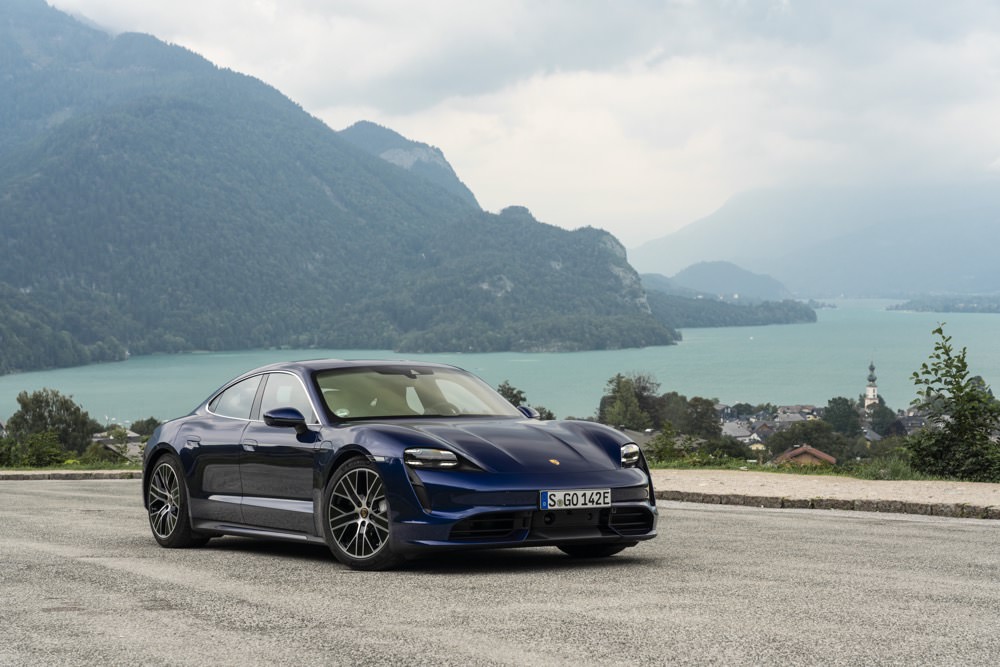
However, this disruption to the normal order of things led to some farcically serendipitous circumstances: those situations whereby it feels as if all the planets are aligning, the cosmic forces are focusing their positive energies on you and whatever gods you care to pray to are smiling down upon your pitiful mortal form.
You see, we were supposed to be driving the Porsche Taycan Turbo S electric vehicle (EV) in late March. And the launch of the 992-generation 911 Turbo S was due to take place overseas in April; it was an event which, regrettably, we could not attend. But, once the Covid lockdown had obliterated both from the calendar, it seemed like an interminable wait until early June, when the astonishing 718 Cayman GT4 was booked in for a week-long evaluation. It just so happened that Porsche then invited us to its UK headquarters for a day, to drive a Taycan Turbo (missing its ‘S’ now, but that hardly matters) and the 992 Turbo S; a day which coincided with the GT4 being in our possession.

Yep, we know – jammy sods, lucky bar stewards, smug, um, solo-sexualists… and various other imprecations too risqué to even publish or asterisk out here. We’re well aware that this is the sort of work-related arrangement that is outrageously fortunate, but we girded our loins for the utter, ah, misery of spending a day in the company of this trio, to try and bring you an objective viewpoint on where Porsche has come from, where it is right now and where it is heading.
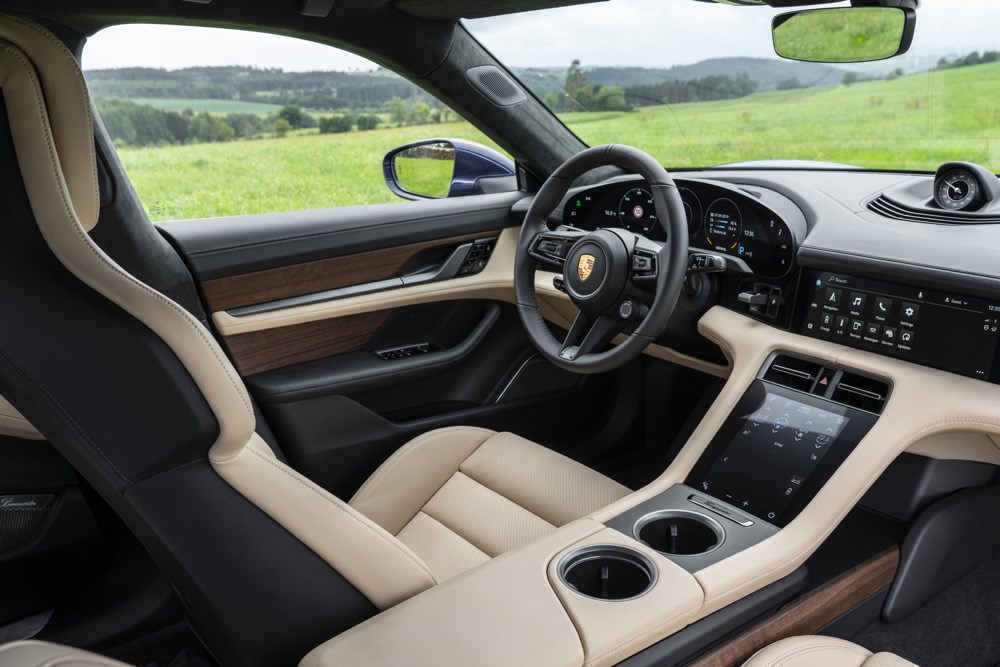
So, other than going ‘these three cars are utterly terrific in their own, beguiling ways’, what is the thread here? Well, all three of them are predicated on moving quickly; that’s a Porsche ‘given’. But consider that the Cayman GT4 arguably represents a breed of Porsche which is on borrowed time. That might seem odd, seeing as this 718-based derivative only landed in 2019 and marked a return of the six-cylinder engine to the Cayman’s midriff, but think about it – it’s a highly focused, highly expensive (in its range), limited-build track-biased car with a normally aspirated engine and no concession to environmental concerns at all. Well, save for one major trick: its 4.0-litre powerplant can shut off half of its cylinders and run as a ‘three’ to save fuel when it’s cruising.
Fossil-fuel-burning motoring with days numbered
But that’s about it. To all other intents and purposes, this is a car all about speed, about the thrill of driving, about a type of fossil-fuel-burning motoring with days numbered possibly in the hundreds, rather than the thousands. And can the Cayman GT4 hope to convince, when the 992 Turbo S hoves into view? With its blistered arches and that oh-so-iconic 911 shape, this is the ultimate derivation so far of the eighth-generation sports car. While GT3 and GT2 versions will be forthcoming, for now the 650hp/800Nm Turbo S is the king of the 992 hill.

It delivers its brutal performance in a wholly different manner to the Cayman GT4. As its name suggests, a pair of variable turbine geometry (VTG) blowers provide forced induction for a 3.7-litre, rear-mounted, flat-six engine which is derived from that found in a contemporary Carrera (only bored out to 3,745cc, and then given piezo injectors and meatier intercoolers), and while its interior is special and a level up from the regular, exemplary cabin of any other 992, it is nevertheless adorned with plush hide seats, a plethora of creature-comfort toys and an ambience of a car which can do the daily grind just as comprehensively brilliantly as it can catapult you into the middle-distance without any sort of warning whatsoever. Where the GT4 is raw and intense, the 992 Turbo S promises to be civilised and discreet. To a degree.
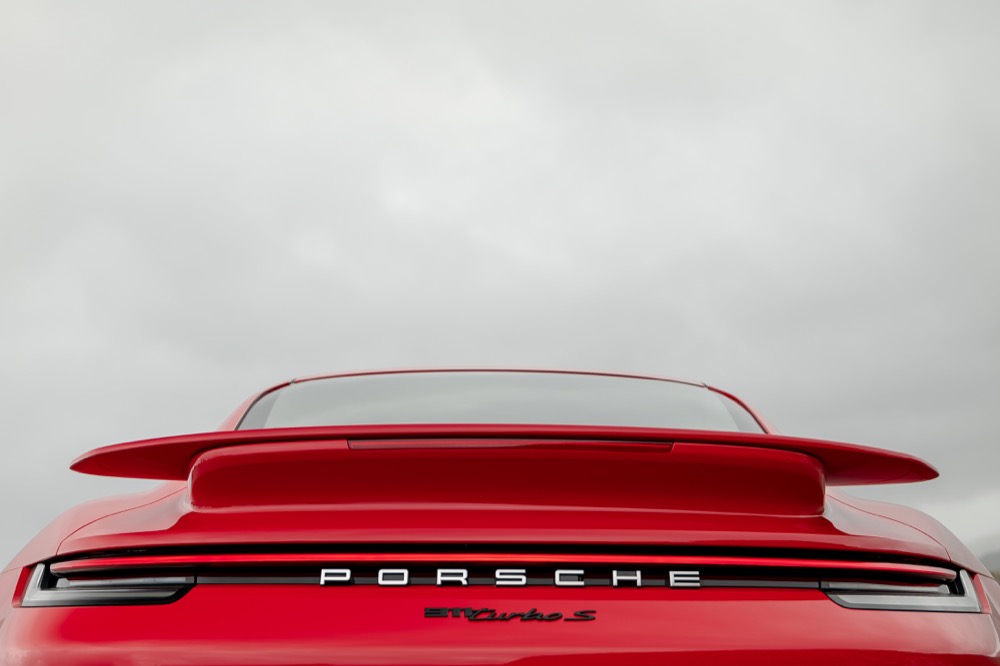
What links the first two cars is the boxer-six engine arrangement, but the final of the three Porsches here doesn’t have an engine at all. Instead, the Taycan Turbo ‘makes do’ with a couple of electric motors, one on the front axle and one on the rear. Between them, these churn out a thumping 460kW (625hp), unless you’ve got the car in Launch Control mode, where an ‘overboost’ function ramps that up to 500kW (680hp). The only output difference between this and the Turbo S is that the latter develops even more grunt in the overboost phase, going to a ludicrous 560kW (761hp). It also gains much extra kit as standard which is otherwise a cost-option on the Taycan Turbo, but you’re unlikely to feel short-changed if you go for the ‘mid-range’ model of the three-strong current Taycan line-up (there’s a 4S variant at the bottom of the tree).
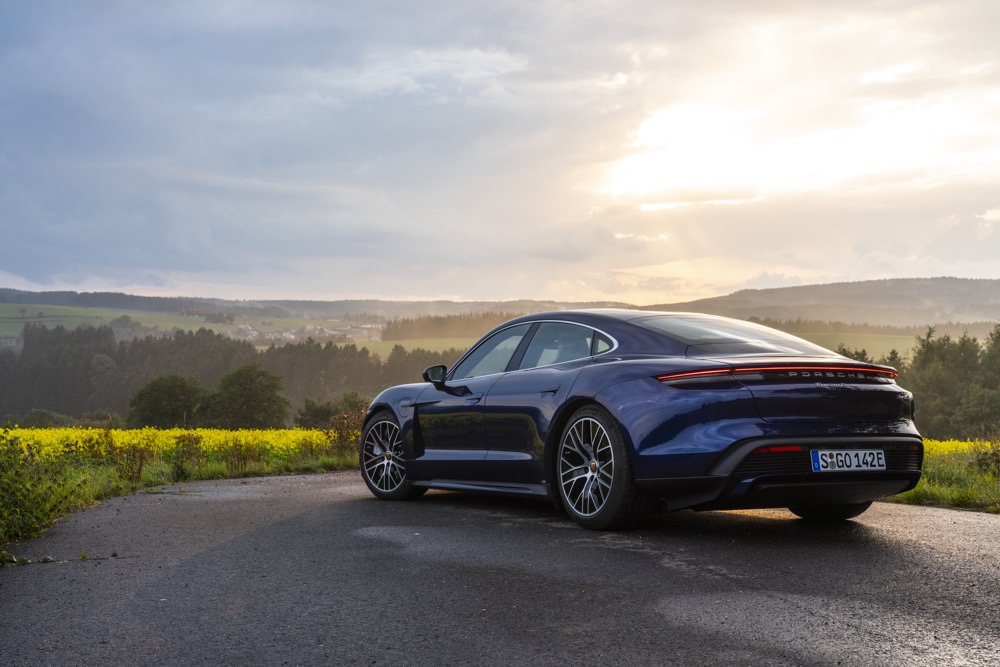
A Turbo without a turbo
If all this talk of ‘overboost’ and ‘Turbo’ is making your engineering teeth itch, because you know a car with no combustion engine can have neither turbos nor boost, panic not; it isn’t Porsche losing its touch, but rather the car company rationalising that customers understand the marque’s naming hierarchy which culminates, in most model lines, with a capital-T-Turbo variant of some sort. So the Taycan was adapted to fit into the same structure, despite its very obvious mechanical differences.
Introductions complete, in terms of the chronology of the extraordinary day in question the GT4 was driven first – primarily to get the hundreds of kilometres to Porsche GB’s HQ in Reading, a town about 65km west of London. As a result, the 718 Cayman didn’t enjoy the most exciting driving roads of the day, as the UK’s M1 and M40 are hardly the sort of dynamic challenges this mid-engined masterpiece was developed for. And yet, it still shines incredibly brightly. Ever since the Cayman, a hard-topped version of the Boxster roadster, first arrived in 2005, there has been a feeling that Stuttgart has been holding it back, tugging on its reins a little, like an over-protective parent. The reason for this restraint is obvious and it’s something of an elephant in the room when you’re talking to diehard Porsche aficionados… but the fact of the matter is that a mid-engined machine is always going to be a finer balanced and, ultimately, better sports car than one with its powerplant slung out beyond the rear axle. In other words, left to run unfettered, the Cayman should turn out to be superior to the 911.
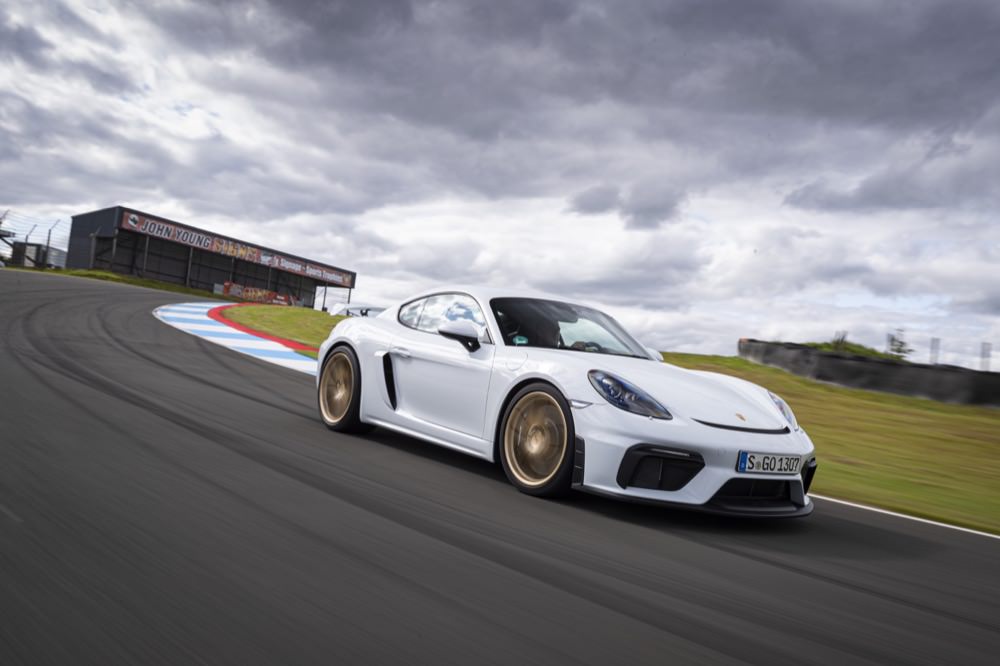
The junior Porsche 911
Which doesn’t suit the current Porsche model hierarchy, in which the 718 must be subservient to the 911, nor will it satisfy the diehard 911 fanboys and girls who have been following this particular carmaker for decades, purely as a result of that very 911 legend. It has been said many times before that ‘icon’ is used too easily in automotive reviews but, in its distinctive rear-engined vehicle, Porsche has a true motoring icon with the 911. Allowing it to be usurped by a mere Boxster-based upstart which only appeared 15 years ago would be unconscionable. Surely…?
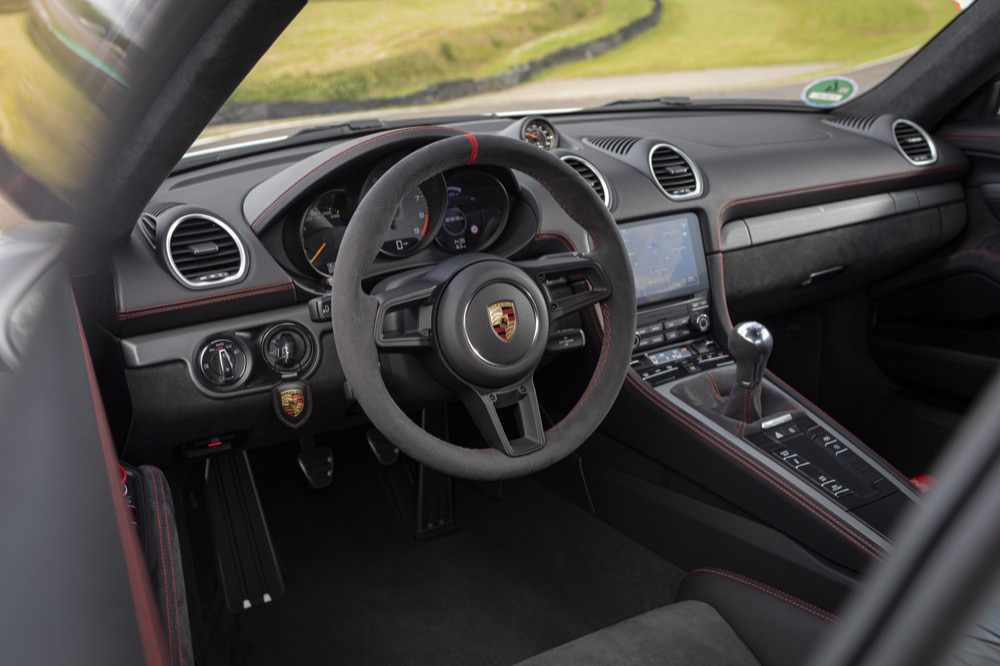
Ominously, the Cayman has shown glimpses over the years of breaking free of its parental shackles. There was the Cayman R of 2011. There was even a 2015-launched GT4 version of the previous-generation midships coupe, which was the first Cayman to receive more power than a 911 from the same era and also the first Cayman to wear the hallowed ‘GT’ lettering on its stubby rump. However, we’re going to argue something vaguely heretic in Porsche-World: this 718 Cayman GT4 is, for us, better than a 991.2 911 GT3 manual.
Sacrilege, maybe, but there it is. Oh, it’s not quite perfect, the GT4, but it gets oh-so-close to the highly improbable manufacturing dream that it’s impossible not to be completely gobsmacked by the thing. If you want the drawbacks, they are these: one, it is double the price of a base 718 Cayman without options and getting on for three times as much with all the desirable kit of our test car fitted; two, when it is switching from one bank of three cylinders to the other while the car is travelling at a steady cruise, in order to save excessive piston wear on one side of the engine, the pitch of the motor changes every five or six seconds and it’s a noticeable, vaguely distracting shift in tone; and three, the gearing is comically long. Almost as comically long as this feature, in fact. Ahem. This 718 will pull 135km/h at the top of second, nearly 190km/h in third. It has six gears to go at in total.

But we can offer a counter-argument for all of these points: one, the GT4 is ten times the car the base 718 is, and the base 718 is hardly shoddy, even taking its flat-sounding, 2.0-litre, four-cylinder turbocharged engine into account; two, the unusual, two-note tune the 718 plays on a motorway cruise soon becomes background noise and nothing more; and three, that gearing might not be ideal in countries with a 110-120km/h national limit, but it’s perfectly manageable in reality. And in Germany? On a racetrack like Spa Francorchamps? It would be perfection. Letting that 4.0-litre engine spool out as you raced up the Kemmel Straight towards Les Combes would be… it would be just heavenly.
A magnificently precise gearbox
Add in that the actual throw of the gearbox is magnificently precise and that the 718 has enough low-down muscle to negate any long-gearing issues (it’ll pull pretty happily and insistently from 80km/h in fifth and sixth), plus the usual sharp throttle/perfectly modulated brake pedal allowing the driver to enact such wonderful heel-and-toe downshifts that the ‘AUTO BLIP’ button on the transmission tunnel is almost totally redundant, and that means we’d happily put up with a car in which you could theoretically drive everywhere using only second gear… provided you didn’t mind damaging your hearing on motorways.
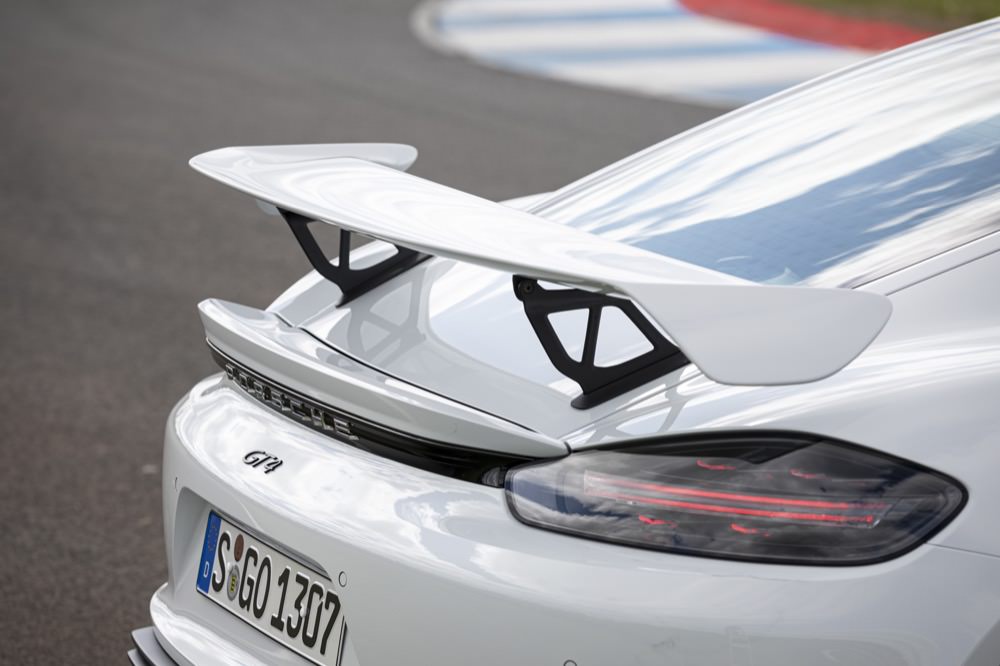
The perfect Porsche recipe?
In every other respect, this car is sublime. Absolutely, totally and completely sublime. Come on; it’s a 425hp, mid-engined Porsche with motorsport know-how and a singular focus on driving reward. How could it be anything else? The steering feel, through the Alcantara rim, is sublime. The turn-in is sublime. The way the 4.0-litre flat-six howls as it reaches through all its revs is sublime. The manner in which it manages to be reasonably comfortable and surprisingly frugal (in excess of 30mpg on a run) is sublime. The fact you’re just sitting in a 718 Cayman and there’s a six-cylinder engine, rather than a boxer four, chuntering away behind your spine is sublime.
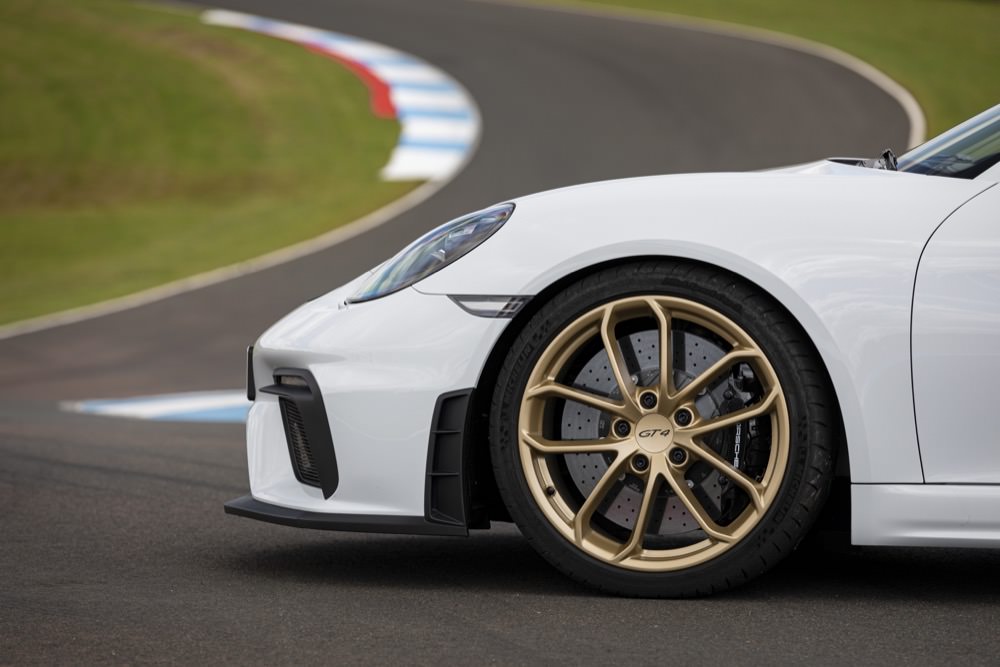
And fast? Oh, it’s fast. It’s stupendously fast, and involving, and rewarding, and delightful, and every other superlative under the sun. Seriously, this is not a car which is overpriced in the slightest; if anything, it’s something of a bargain.
Jumping straight from the intense thrills of the GT4 into the Taycan Turbo is something of a culture shock, mainly because of the preternatural fashion in which EVs go about their business. But once you’ve reattuned to the rich, thick, silken silence of travelling at speed in a high-spec EV like this, you can focus in on the sheer genius of engineering which has gone into the Taycan. Porsche needed this car to feel like a Porsche, not just an EV with some Stuttgart shields plonked on it, and boy, has the company hit the bullseye when it comes to aceing the design brief.
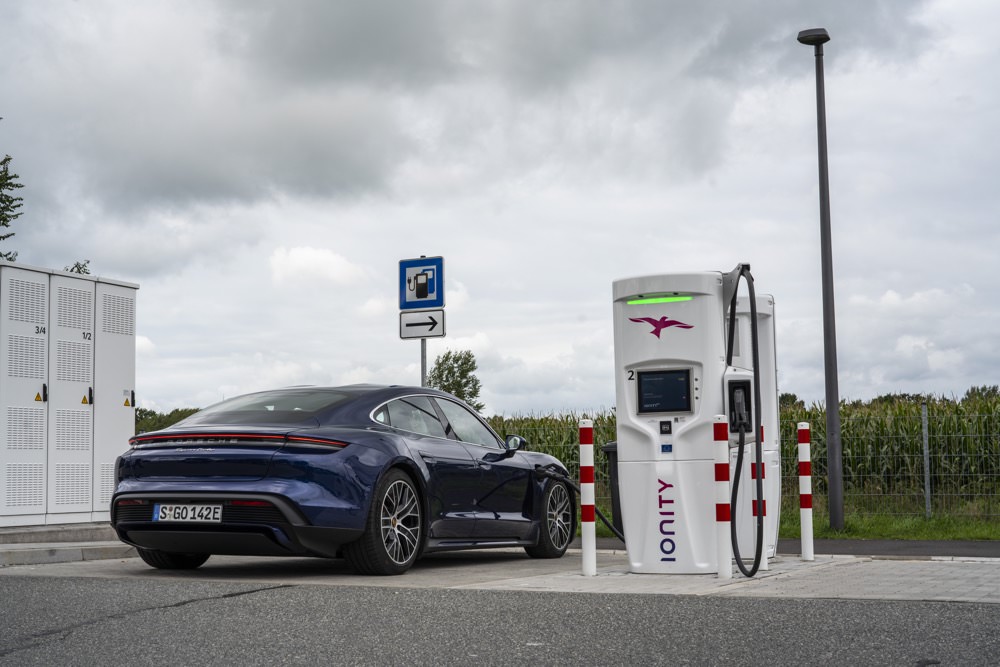
850Nm of torque on tap at all times
Honestly, the speed of the Taycan Turbo is freakish. Even if you’ve sampled its key rival, the Tesla Model S, in its full pomp, the Taycan still feels the more savage of the two. First time we enacted roll-on acceleration when exiting a motorway sliproad, we’d have filled the Turbo’s cathedral-quiet cabin with a volley of rapid-fire expletives, if only we’d had any time at all to process and then react to the seemingly instantaneous shift from legal to ‘whoops, officer’ speeds. When you’ve got 850Nm of torque on tap at all times, channelled through two gearboxes (single-speed front, two-speed rear) to all four wheels via Porsche Traction Management (PTM), you learn to treat the throttle pedal with an immense amount of respect. And fear for your licence, more pertinently.
Outright speed was never something for which the Taycan was going to lack, though. And neither was an innate sense of quality when you’re sitting in the cabin. With its fancier, more digitalised cabin than any other Porsche model, the Taycan Turbo manages to at once convey its familial links to its stablemates and yet to feel like no other model from the German company built until this point. So the Taycan’s brilliance all comes down to the way it handles.
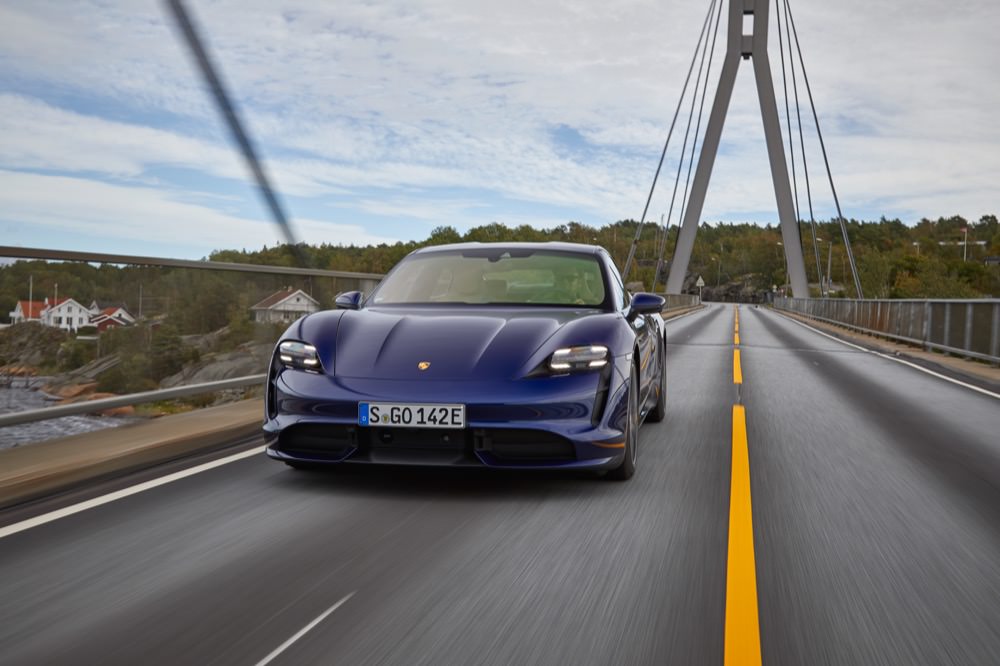
At 2,305kg, this is heavy. Only the top models of Cayenne and Panamera Sport Turismo weigh anything like as much in the current Porsche canon and weight, as any keen driving enthusiast will tell you, is a predator of driving fun. You can lob all the technological know-how and skills you like at a fat car, but no matter how well it masks its mass at lower speeds, it will always feel like a fat car at the limits of adhesion.
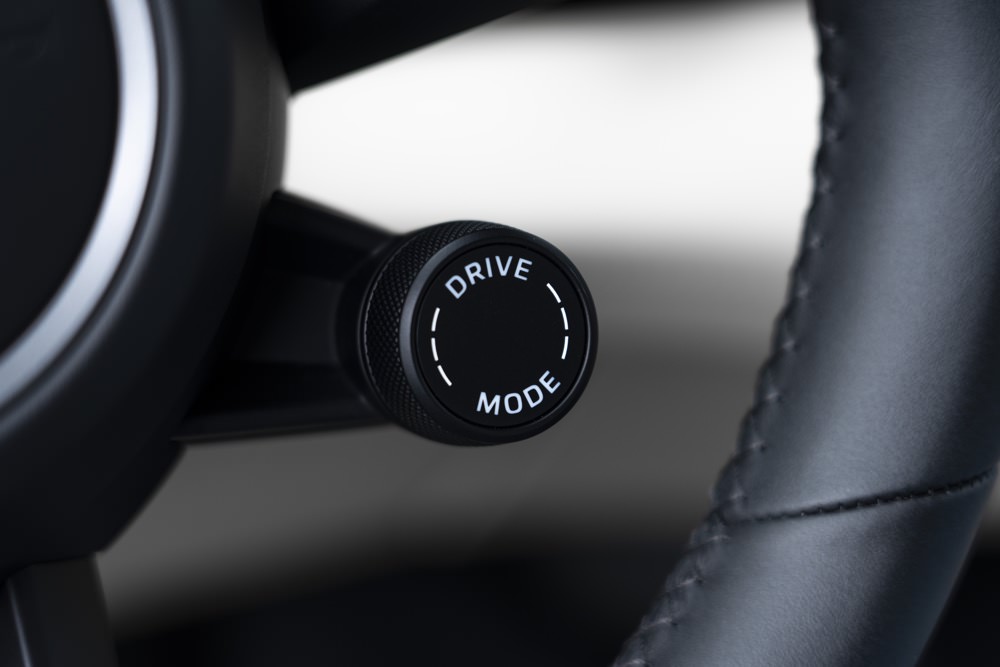
Every inch a sports saloon
Except… the Taycan Turbo somehow doesn’t. Sure, there are very odd occasions when you’re standing on its left-hand pedal that you wonder if the optional Porsche Ceramic Composite Brakes (PCCB) might not be overkill after all, but other than that, the way this thing changes direction and feels alive, alert and agile in corners is, if you’re an engineer from a rival company to Porsche, simply disgraceful. The Taycan is every inch a sports saloon as good as its Panamera big brother and it’s an utter hoot to throw around on a snaking, sinuous road.
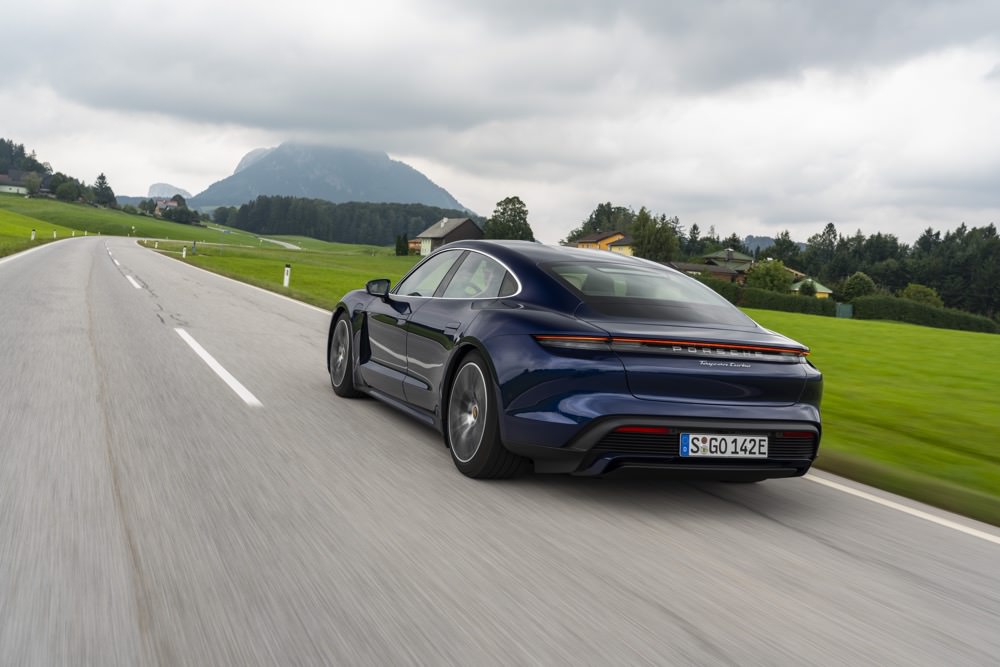
What the Taycan really does, though, is offers genuine hope for the future. With its optional Porsche Electric Sport Sound (PESS) system providing a unique but enjoyable soundtrack to fast driving, it shows that a future of EVs can involve plenty of motoring excitement. Hopefully, what it will precipitate is the democratisation of this sort of EV performance and handling, because it is clearly not the cheapest nor most accessible electric car in the world, but as a beacon of a brighter, cleaner future, the Taycan is unquestionably magnificent and it’s also, in our opinion, easily the best EV on the planet right now.

Weirdly enough, the 992 Turbo S has an even harder job on its hands than the Taycan. Doubters of electric power will be easier to win over than staunch petrolheads who are sniffy about the 911 Turbo’s ‘do-it-all’ abilities. Despite the messianic (another of those grandiose words again) 930 Turbo first appearing in 1975, ever since the 911 GT3 became ‘a thing’ in 1999 for the 996-generation car, the Turbo has been seen as the poser’s choice of go-faster Porsche.
That mindset didn’t even change with the 991.2 Turbo S, all 580hp and 750Nm of it, which arrived in 2016. The problem with the Turbo, it would seem, is that it just makes supercar speed that bit too easy. With all-wheel drive and an automatic PDK gearbox, you get in, point the prow of it at any road you care to mention and then depress the throttle. Hold on for dear life, steer a bit, get to where you were going faster than almost any other production vehicle you could mention. Technically, that’s a towering achievement; romantically, it’s all just a bit soulless. Especially when compared to a 9,000rpm, nat-asp 4.0-litre 911 with a manual ‘box, big fixed rear wing and the full Clubsport package.
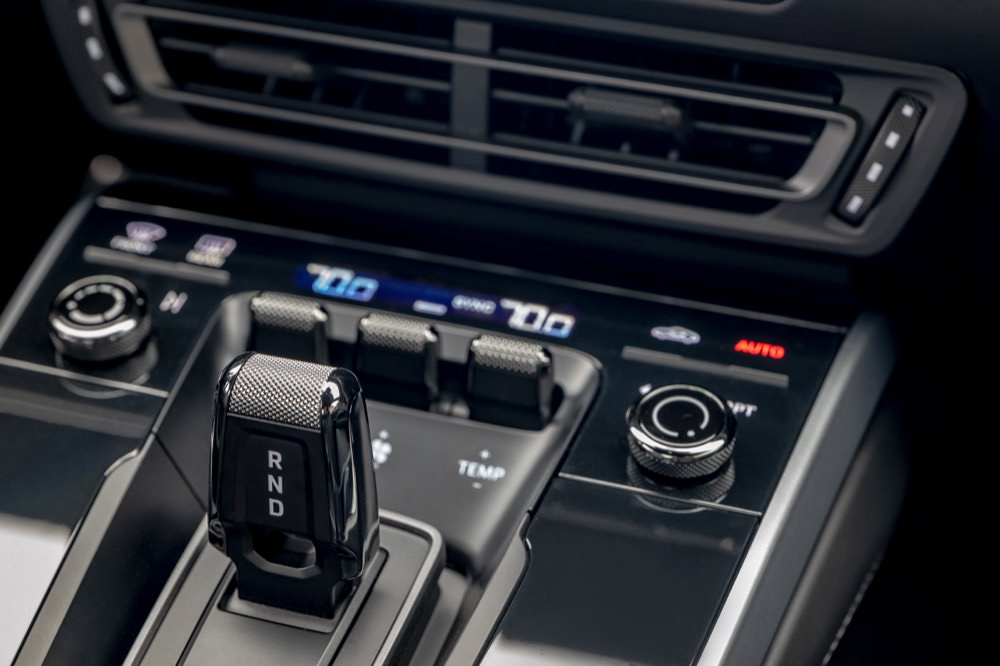
Porsche is maybe trying to tempt a few prospective 992 GT3 buyers to at least turn their heads and seriously consider the Turbo S this time around, though. And what an astonishing job the company has made of such a Herculean task. With a 45mm-wider front and 10mm-wider rear track than the current Carrera S, the idea with the 911 Turbo S is that it will understeer less when it runs out of grip. It also has hulking 20-inch front, 21-inch rear wheels (sitting over standard-fit PCCB discs that, at 420mm-diameter on the leading axle, are half-an-inch bigger than the 16-inch Fuchs alloys on the original 930 Turbo), as well as a whole gamut of Porsche acronyms and initialisms to corral the massive outputs of the engine. Perhaps of more interest is the full active aerodynamics system, most easily spotted when the car is in Sport Plus mode and it therefore deploys its otherwise-hidden front splitter while simultaneously elevating a section of that enormous rear wing.
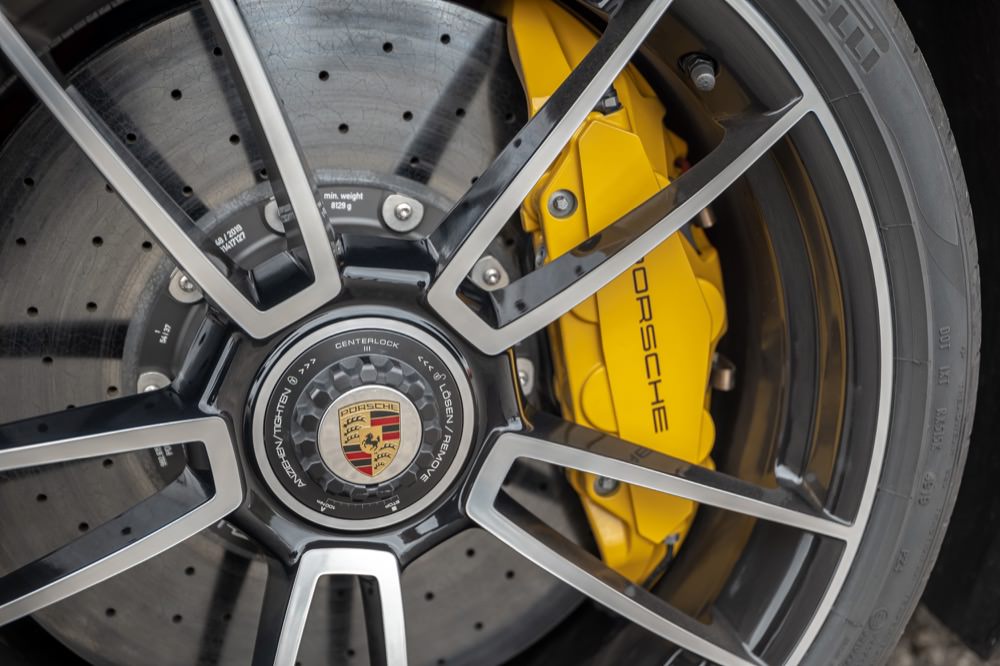
And still, on a day where the GT4 has growled and screamed its way to an 8,000rpm limiter and the Taycan has silently whooshed you into the middle of next week on a wave of whispering electric power, the sheer ferocity of the 992’s twin-turbo performance is startling. There’s turbo lag, especially if you’re in manual mode with the exceptional eight-speed PDK transmission and you’ve got less than 2,000rpm showing in a lowish gear, but once those twin VTGs are powered up, it feels like there’s no faster road car on Earth than the Turbo S. It is shockingly quick and unstintingly relentless as it piles on the bigger speed numbers, which is where it differentiates itself from the realms of ‘very fast’ motors and plants itself firmly in the ‘what the actual…’ echelon of hypercars and the like.
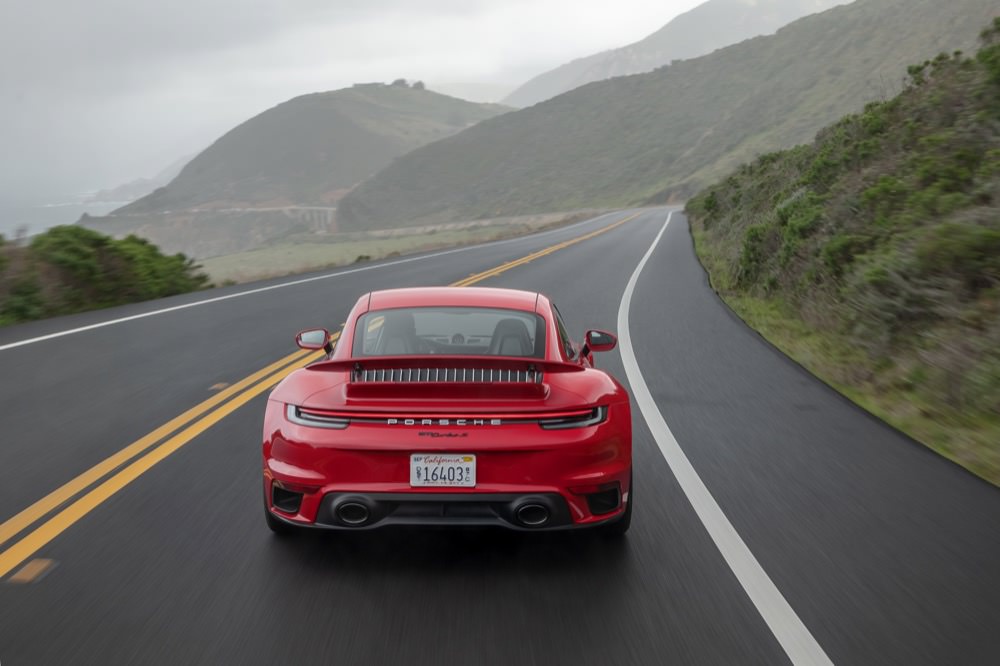
Yet it’s playful in the corners. There are ginormous reserves of mechanical grip from its mega-wide tyres and all the traction reassurances of the PTM all-wheel drive, but despite these features the 992 Turbo S manages to convey a feeling that it is dancing and balanced in corners, rather than steadfast and leaden. There’s a sensation that not anyone could extract the best from this car, instead of it being a weapon of mass destruction that’s available to all. There’s all the gracefulness and good manners of the 911 when you’re not caning it, albeit with a bit more tyre roar in the cabin and a slightly firmer-edged ride quality. There’s a feeling that this is easily the greatest 911 Turbo of all time, by some considerable distance, and also that it will not be easily overshadowed once its GT-badged siblings arrive in the coming months and years.
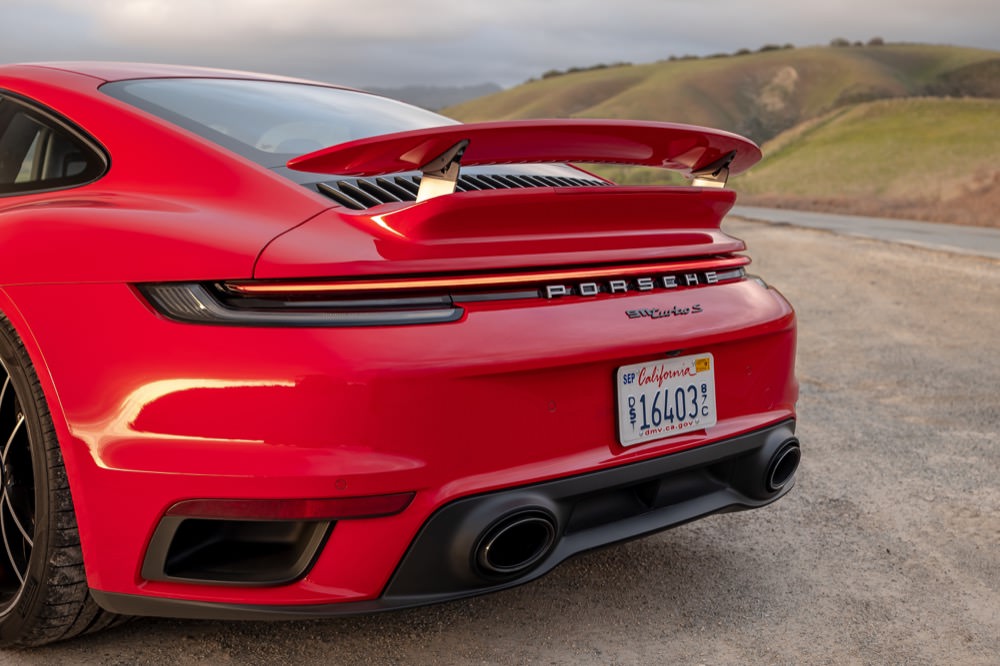
As a tremendous, wide-bodied way of signing the day off, the 992 Turbo S would have been more than good enough. And there was certainly an interest in trying to coax the Taycan the 250km home, to see if its range claims lived up to the undoubted dynamic excellence. But, at the end of this day to end all days, the right car presented itself for the journey back to base.
That we yearn after a 718 Cayman GT4 with every fibre of our being is perhaps not surprising, and it also raises the disturbing thought that we’re hankering after a motoring epoch that is drawing to a close; or, in other, more succinct words, that we’re rooted in the past. But we’re not: if what this incredible day has taught us is nothing more than ‘Porsche is a bloody blindingly brilliant car company’, then it was worth it. But there’s more to it than that – in the form of the 992 Turbo S and the Taycan Turbo, the marque is flexing its muscles and showing it can still be relevant, desirable and outstanding in a future dominated by environmental concerns. That is a heartening conclusion, in and of itself.
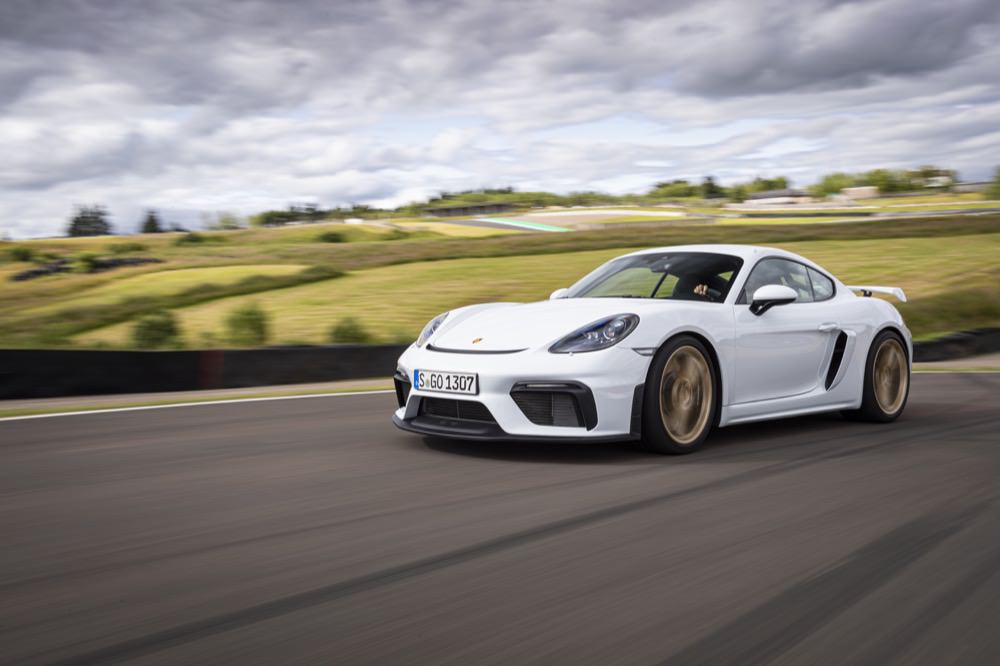
But we’ll cling on to the singular focus of the GT4 for now. This is a car which has no modern rivals, as far as we can tell; it is peerless. The top-dog 718 Cayman is what you would probably design if you were given a blank sheet paper and told ‘conceive for me the most talented sports car you can think of’. It is phenomenally, painfully, marvellously, gut-wrenchingly good. And so, at the end of a magical six hours in, er, Reading, we clamber into the shapely bucket seat of the Cayman, fire up its mid-mounted jewel of an engine, permit ourselves the broadest of broad grins, and know that we’re in something ultra-special, right here. The best road-going Porsche ever? Ooh, now that’s a ridiculously hard call to make. We’ll just settle for it being the best car Porsche makes right now.



